Members of the Aerial Experiment Association
The Aerial Experiment Association was officially comprised of five members.
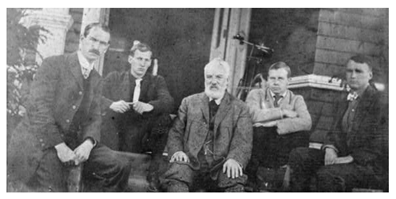
L to R: Glenn H. Curtiss, Douglas McCurdy, Dr. Alexander Graham Bell,
Frederick 'Casey' Baldwin and Lt. Thomas E. Selfridge.
The five members of the Aerial Experiment Association were from two distinct generations. Dr. Bell was the senior scientist-inventor with an established reputation and prominent public profile. The younger generation of four bright, energetic and dedicated men was a perfect mix of talents to take on the task of meeting the goal of the Association: "To get into the air."
Dr. Bell was an American citizen with strong Canadian roots and an early childhood spent in Scotland. Curtiss and Selfridge were Americans. McCurdy and Baldwin were Canadians. The blend of skills, personalities and energies fueled one of the most productive groups of aviation pioneers.
In addition to the five members of the AEA, Mabel Hubbard Bell, wife of Dr. Bell, was very prominent in the affairs of the Association. Her provision of funds and constant support during the brief period when the Association conducted their work is often overlooked. A brief biographical segment on Mrs. Bell is therefore also included below.
Alexander Graham Bell:
March 3, 1847 – August 2, 1922
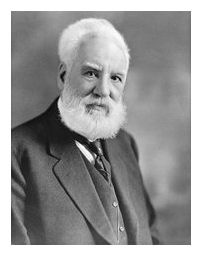 Alexander Graham Bell is widely known as the inventor of the telephone. His patent for the telephone was issued on March 7, 1876. The patent led to the formation of several companies by Bell. He created a company to manufacture telephones and others to develop and install municipal telephone systems. The patent and subsequent growth of his companies provided him with considerable wealth.
Alexander Graham Bell is widely known as the inventor of the telephone. His patent for the telephone was issued on March 7, 1876. The patent led to the formation of several companies by Bell. He created a company to manufacture telephones and others to develop and install municipal telephone systems. The patent and subsequent growth of his companies provided him with considerable wealth.
Bell was a pioneer in speech and sound research involved in understanding the physical condition of deafness. His work to assist deaf people to learn to speak and utilize sign language is well documented and widely admired. It was as a result of his work with the deaf that he met Boston lawyer Gardiner Hubbard who was seeking a teacher for his daughter Mabel.
The association with Gardiner Hubbard, his wife Gertrude McCurdy and daughter Mabel was an important one. Bell married Mabel and worked closely with Gardiner Hubbard on a number of projects and business enterprises over the years.
Bell was truly one of the great scientific and creative minds of the late 19th and early 20th centuries. He utilized his wealth from the invention of the telephone to explore other areas of endeavour. He was instrumental in the formation of the National Geographic Society and its journal, The National Geographic Magazine, one of the most widely recognized journals in the world. He founded the acclaimed Volta Institute to further work on the study of education for the deaf and started the prestigous journal Science, which still publishes major science papers to this day.
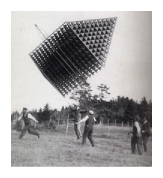 Bell's pioneering work with the tetrahedral form led to a number of applications. The use of the tetrahedral in the structure of large kites, some of them big enough to carry a person aloft, was remarkable. His experimentation with the tetrahedron was used in construction projects (a tower on his property at Beinn Breagh in Cape Breton, N.S. and other structures) as well as in kite framing. Some of the sketches in his notebooks of tetrahedral design ideas show how enamored he was with the utility and strength of the tetrahedron as a three dimensional structure.
Bell's pioneering work with the tetrahedral form led to a number of applications. The use of the tetrahedral in the structure of large kites, some of them big enough to carry a person aloft, was remarkable. His experimentation with the tetrahedron was used in construction projects (a tower on his property at Beinn Breagh in Cape Breton, N.S. and other structures) as well as in kite framing. Some of the sketches in his notebooks of tetrahedral design ideas show how enamored he was with the utility and strength of the tetrahedron as a three dimensional structure.
Other efforts in the development of early flight were achieved through his association with the talented group of individuals known as The Aerial Experiment Association.
Dr. Bell was named as Chairman of the Aerial Experiment Association and he ensured that all the work of the association was well documented with recorded and published notes as well as with photographs.
Bell's career as a teacher of the deaf, his work with the invention of the telephone, his work with early aircraft and his work with the development of hydrofoils makes him one of the great inventors of all time.
For additional information on Bell's life and work, American History in Video presents a detailed video documentary overview of his life, Alexander Graham Bell: Voice of Invention, that is well worth viewing.
Frederick Walker "Casey" Baldwin
Jan. 2, 1882 - Aug. 7, 1948
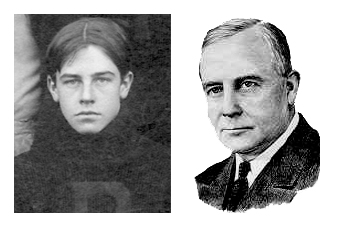 Casey Baldwin was born in Toronto, Ontario, the son of Robert and Elizabeth Mary Baldwin. Casey's grandfather was Sir Robert Baldwin, a Canadian Prime Minister prior to Confederation. On January 9, 1893 he was enrolled by his parents at Ridley College, a highly respected private school in St. Catharines, Ontario. He entered the school in the mid-year in 2nd Form (7th Grade today). He graduated from Ridley College after completing his secondary school education on June 26, 1900.
Casey Baldwin was born in Toronto, Ontario, the son of Robert and Elizabeth Mary Baldwin. Casey's grandfather was Sir Robert Baldwin, a Canadian Prime Minister prior to Confederation. On January 9, 1893 he was enrolled by his parents at Ridley College, a highly respected private school in St. Catharines, Ontario. He entered the school in the mid-year in 2nd Form (7th Grade today). He graduated from Ridley College after completing his secondary school education on June 26, 1900.
Following his graduation from Ridley, Baldwin attended the University of Toronto where he studied electrical and mechanical engineering. He graduated from the University of Toronto in the spring of 1906.
Baldwin was actively involved in sports while at Ridley and the University of Toronto. In university he was captain of the cricket team in 1904 and then captain of the Dominion Rugby Intercollegiate football team in the fall of 1905. He was also active in baseball, fencing and golf. Baldwin's skill at bat in both cricket and baseball earned him the nickname of 'Casey' which would follow him all his life. His friends began calling him 'Casey' after the character in the classic Earnest Thayer poem, "Casey at the Bat" which was written in 1888 and was very popular during Baldwin's time in university.
While attending university, Baldwin became friends with Douglas McCurdy, a fellow student, who was from Baddeck, Nova Scotia. While at university Baldwin and McCurdy followed with interest news of the pioneering efforts of inventors to try to figure out ways to build successful flying machines.
Early in the spring of 1906 Mabel Bell, A.G. Bell's wife, wrote to Douglas McCurdy inviting him to bring some young friend home to Baddeck who would be interested in Bell's work with kites and flight.1
As he was about to leave the university for home, McCurdy invited Baldwin to spend the summer of 1906 in Baddeck where McCurdy's father worked for Alexander Graham Bell as personal secretary. Since Casey Baldwin had no other immediate plans he thought it would be an interesting way to spend some time seeing Canada's east coast and getting to meet the famous Dr. Bell.
After three days of rail travel they arrived in Baddeck. McCurdy introduced Baldwin to the Bells and before long the two young men were heavily involved in assisting Alexander with his kite experiments. Mabel was delighted. Although Casey's plan was to spend a couple of weeks in Cape Breton, this turned out to be the beginning of a forty year association between Baldwin, the Bell family, and Baddeck.
Bell spent time showing the two young engineers his progress with kites and in particular his belief in the tetrahedral structure as having great promise since it was light and strong. Baldwin was offered a salary by Bell and they began work to construct a steel tetrahedral tower with the intention of demonstrating the strength of such structures. First a model was constructed and then an eighty foot steel tower was erected as proof of ease of construction and the integral strength of tetrahedral framed structures.
Baldwin worked with Bell through the fall of 1906 and stayed on through the winter and spring of 1907. He gathered information on flight from numerous sources to expand Bell's library of materials on the topic and the two built many models to test their theories of kite construction with the tetrahedral form.
In the spring of 1907 Douglas McCurdy returned from the University of Toronto, a graduate engineer. Now Bell had two fine, bright young assistants to work with.
In the summer of 1907 two additional visitors would arrive at the Bell summer homestead in Beinn Breagh. With the arrival of these two American visitors, the direction and energy level of their explorations in the science of flight would forever change.
Upon the formation of the Aerial Experiment Association, Casey Baldwin took on the duties of chief engineer of the Association.
Following the dissolution of the AEA, Baldwin remained in the employment of Dr. Bell to work with him on a number of projects.
In 1912 Casey Baldwin returned to St. Catharines, Ontario to marry Kathleen Stewart Parmenter. Alexander Graham Bell and Mabel Bell attended the wedding2.
Among the projects that Casey undertook with Bell following their work with flight was the very successful experimentation with hydrodromes (hydrofoils) which culminated in the construction of a hydrofoil boat, the HD-4, that set the world speed record of 70.86 miles per hour (114.04km/h). The HD-4 held the world's speed record until 1929.
Casey Baldwin was very close to both Alexander and Mabel Bell. He managed the Bell estate and various Bell enterprises for a period of time after his mentor's death. Baldwin went on to be elected to the Nova Scotia Legislature in 1933. He spent the remainder of his life in Nova Scotia.
J.A. Douglas McCurdy
August 2, 1886 - June 25, 1961
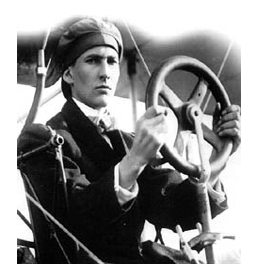
John Alexander Douglas McCurdy was born in Baddeck, Nova Scotia. His father was the village postmaster until he became employed by Alexander Graham Bell as Bell's personal secretary. He had one brother.
Douglas became the preferred name by which McCurdy became known. After some education in the village school at Baddeck, Douglas was sent to St. Andrews School in Aurora, Ontario to complete his elementary and high school education. The Bell family assisted with paying for Douglas' private school education.
McCurdy enrolled in mechanical engineering at the University of Toronto and graduated with an engineering degree in 1906. While at university he became a good friend of Frederick Walker 'Casey' Baldwin. He encouraged Baldwin to visit Baddeck and see the work with large kites being carried out there by Dr. Bell.
Following graduation Douglas McCurdy returned to Baddeck to work with Dr. Bell. He became a member of the Aerial Experiment Association and acted as its treasurer for the duration of its existence.
After the AEA disbanded at the end of March 1909, McCurdy continues to work as a pilot and once again connected with Glenn H. Curtiss, one of his associates in the AEA. McCurdy worked as a demonstration pilot and flight instructor for the Curtiss Aviation Schools and travelled widely across the United States in that capacity.
In 1910 he was awarded the first Canadian pilot's license. He completed a long distance flight over water from Florida to Cuba in 1911 demonstrating the sturdiness and durability of Curtiss aircraft.
During the Second World War McCurdy served the Canadian government as Assistant Director General of Aircraft Production.
Later in life he returned to Nova Scotia and was appointed lieutenant-governor of Nova Scotia in 1947.
In 1959 he attended the 50th anniversary celebration of the flight of the Silver Dart at Baddeck and was a featured guest at the festivities. On that occasion, CBC Radio Canada interviewed McCurdy and asked him to describe his flight, as he recalled, it a half century after the event. McCurdy can be heard describing the event in this archival record at the CBC archives.
The text of McCurdy's description of the flight of the Silver Dart is interesting reading:
McCurdy: "“The whole scene is still very vivid to me. It was a brilliant day in more ways than one. The sun was glaring down on the ice of Lake Bras d'Or, which is near Baddeck. The town had turned out in a festive mood, done up in mufflers and heavy fur hats. The town, by the way, consisted largely of very doubtful Scotsmen. Most of them were mounted on skates – the kind you strap to your feet. They didn't say much – just came to wait and see. The aircraft, or aerodrome as it was called in those days, which we had christened the ‘Silver Dart', was surrounded by people. During the early afternoon it was wheeled into place. The propeller was cranked and, with a cough, the motor snorted into place. I climbed into the pilot's seat. With an extra special snort from the motor, we scooted off down the ice. Behind came a crowd of small boys and men on their skates – most of them still doubtful I would fly. With a lurch and a mighty straining of wires we were in the air. It was amusing to look back and watch the skaters – they seemed to be going in every direction – bumping into each other in their excitement at seeing a man actually fly. In taking off I had to clear one old Scot, so doubtful I would fly, that he had started off across the ice with his horse and sleigh. I think they both had the daylights scared out of them. I traveled three-quarters of a mile at a height of about sixty feet before again coming to the surface of the ice. I will say, the doubting ones overcame their feelings in short order.”
Glenn Hammond Curtiss
May 21, 1878 - July 23, 1930
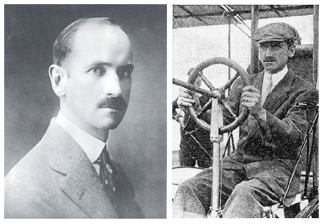
Glenn Hammond Curtiss was born in Hammondsport, New York, a small town at the southern end of Lake Keuka. His father died when he was only four years old so the role that his mother and grandmother played in his upbringing was very significant. He earned money at an early age working in the vineyards that supplied grapes for the wineries of Hammondsport.
Later Curtiss spent time tinkering with gadget and was always handy at figuring things out as well as repairing and building things. He became interested in the new safety bicycles that were coming into prominence in the late 1880's. He worked for a local pharmacist, Richard Smellie, who opened a small bicycle shop. Glenn kept the cycles in repair and gradually became known as an expert. In addition, he was a champion bicycle racer throughout New York state. Taking his interest in bicycles one step farther, Glenn opened a small bicycle shop of his own and eventually turned to designing and building his own improved models. He was so successful that he opened a second shop in the larger town of Bath NY a few miles south of Hammondsport.
Curtiss saw the potential for powering a bicycle with a small engine and set about to build his own using some castings for the cylinder walls that he ordered by mail. After much tinkering he got the engine to work and power one of his bicycles. This led him to designing his own engines, casting the parts and building motorcycles. His engines were reliable, light weight and produced good power. This combination of light weight and high power won him contracts from other bicycle manufacturers to produce engines for their plants.
The Curtiss Motorcycle Company led him to employ many local villagers. He gained a reputation as a hard working, inventive, and honest businessman.
One of his motorcycles found its way into the view of Capt. Thomas Baldwin of California, an early pioneer builder of the new semi-rigid balloons that were pioneering a form of air transport. In 1904, Baldwin ordered one of Curtiss' motorcycle engines for his balloon and began to rely on Curtiss for custom applications of the engine to drive his balloons by propeller. Baldwin eventually became so impressed with Curtiss and his manufacturing techniques that he moved his balloon factory to the village of Hammondsport to be close to Curtiss' plant.
Curtiss wrote to the Wright Brothers of Dayton, Ohio, to see if they might be interested in some of his engines for their work with their Wright Flyers. He even travelled to Dayton while on a longer business trip to see if he could secure some work from the Wrights. Although the meeting was cordial, the Wrights declined his offer and continued to build their own engines.
Curtiss raced his motorcycles in races and speed contests, just as he had earlier in his life when he was a bicycle racer. In 1903 he set the world land speed record of 103 kn/h (64 mph) over a distance of 1.6km (1 mile). In 1907 he set a world record of 136.36mph (219.31km/h) at Ormond Beach, Florida. Curtiss used a 40-hp V8 powered motorcycle of his own design and construction. For four years, until 1911, he was known as "The Fastest Man on Earth".
While exhibiting his motorcycles at the New York Automobile Show in 1906, Curtiss came into contact with Alexander Graham Bell who had been invited to exhibit his large tetrahedral kites that were gathering much attention in the press. Bell was looking for a light, powerful motor to lift his kites with a person on board. Bell came away muich impressed with Glenn Curtiss.
In the late summer of 1907 Curtiss was invited to Beinn Breagh, the summer estate of the Bell family in Baddeck, N.S. to see Bell's kites and discuss the potential of using engines to provide power for the kites. It was during this visit that he met Casey Baldwin and Douglas McCurdy who were already in Bell's employ, and Lt. Thomas E. Selfridge of the U.S. Army who was also visiting Bell to discuss aviation matters.
The four young men and Bell hit it off very well and spent days with the kites trying different things to learn more about their lift. The evenings were spent socializing with the Bell family in the large home and discussing matters of flight for long hours. Sensing the compatibility of these bright young men with one another and with Dr. Bell, Mabel Bell proposed that they should form an association to continue their experiments with flight and attempt to solve some of the many problems associated with powered, human controlled flying machines.
Curtiss accepted the idea and became Director of Experiments with the Aerial Experiment Association.
Following Curtiss' role in the Aerial Experiment Association, he formed an aviation company that become one of the principal forces in advancing the design and development of aircraft during the early years of aviation. His work with aircraft design that enabled planes to take off from and land on water made his company a leader in the production of seaplanes. His work with the United States armed forces helped to create the aircraft and conditions necessary for the modern aircraft carrier.
A short video documentary about Glenn Curtiss, developed by "For People Who Think.com" details some of the achievements of this important aeronautical pioneer.
Lt. Thomas Etholen Selfridge
February 8, 1882 - September 17, 1908
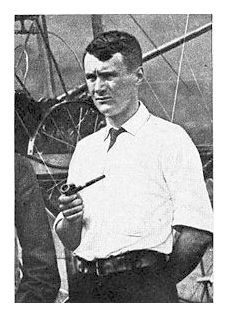 Thomas Etholen Selfridge was born in San Francisco, California. He attended the United States Military Academy at West Point, on the Hudson River in New York State from 1899-1903. Selfridge graduated in the top one-third of his class. While there he was a classmate of Douglas MacArthur who graduated first in the class of 1903.
Thomas Etholen Selfridge was born in San Francisco, California. He attended the United States Military Academy at West Point, on the Hudson River in New York State from 1899-1903. Selfridge graduated in the top one-third of his class. While there he was a classmate of Douglas MacArthur who graduated first in the class of 1903.
Selfridge was commissioned as an officer in the United States Army Field Artillery and was assigned to the U.S. Signal Corps in Fort Myer , Virginia, not far from Washington D.C. Shortly after his arrival at the base he was assigned to the Aeronautical Division of the Signal Corps. Having developed an interest in aviation while at West Point, Selfridge had read all he could on the fledgling efforts of men to successfully build and pilot airplanes.
Following news of the successful flight of the Wright Brothers at Kill Devil Hill near Kitty Hawk, N.C. Selfridge made it a point tolearn as much as he could about their airplane and their flight.
The Army was looking at the military potential of manned aircraft and had purchased a dirigible, Army Dirigible Number One, in July 1908, from Thomas Scott Baldwin an American balloonist of some significant accomplishments. Baldwin was powering his dirigibles with motors developed by Glenn H. Curtiss of Hammondsport, NY. Baldwin was so impressed with Curtiss' engines that he moved his dirigible factory from California to Hammondsport in 1906.
Lt. Selfridge became one of three pilots trained to fly the Army Dirigible. He strongly believed in the potential for aviation as an effective modern tool for Army opeations. As a result, in 1907 Selfridge approached the Wright Brothers about being assigned as a volunteer to assist them in their work in furthering the development of their airplane design. The Wrights declined in a letter stating that they had no need for part time staff and that they were not adding any full-time people to their operation.
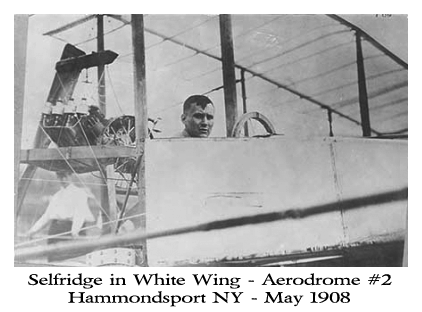 Being stationed near Washington, Selfridge had occasion to hear Alexander Graham Bell speak on aviation and his experiments with kites in an address to the Smithsonian Institution. He approached Bell and had a conversation with him that thoroughly impressed the scientist and made a lasting impression on him. Bell invited him to attend his summer home in Baddeck where he could witness the work that was being undertaken with large kites.
Being stationed near Washington, Selfridge had occasion to hear Alexander Graham Bell speak on aviation and his experiments with kites in an address to the Smithsonian Institution. He approached Bell and had a conversation with him that thoroughly impressed the scientist and made a lasting impression on him. Bell invited him to attend his summer home in Baddeck where he could witness the work that was being undertaken with large kites.
Selfridge made the trip to Beinn Breagh, the Bell home in Baddeck, in the late summer of 1907 at the same time that engine manufacturer Glenn H. Curtiss was invited to be there. Casey Baldwin and Douglas McCurdy were already there working with Bell on the kites when Selfridge and Curtiss arrived.
The four bright young men were all keenly interested in the huge kites of Bell and in the general potential of aviation at that time. There were many energetic conversations in the evenings after dinner in the grand house of the Bells. Mabel Bell, Dr. Bell's wife, noticed the synergy of the four young men who added energy and focus to Bell's work. This was something that she had hoped might occur at some point, and so she proposed forming an association to further explore and experiment with flight.
Selfridge assumed the duties of Secretary of the Aerial Experiment Association.
Selfidge and Curtiss returned to Baddeck in late November. Selfridge made his first flight on December 6, 1907. The flight was in Dr.Bell's huge tetrahedral kite, the Cygnet, made of 3,393 winged cells. Towed behind a steamer on Bras d'or Lake, the Cygnet with Selfridge aboard took flight to an altitude of 168 feet (51m).
Selfridge flew in the Cygnet for over seven minutes until the large kite started to drift down due to decreasing breze which could not be totally offset by the progress of the small steamer. The Cygnet sank into the water of the lake and before the tow rope could be cut, the kite was partially dragged under the water and Selfridge had to free himself from the device. He came to the surface in the frigid waters of the lake. He was quickly rescured and warmed up.
The flight of the Cygnet made Selfridge the first passenger on any heavier-than-air craft in Canada. Bell immediately wired the major newspapers and the story was given wide press publication due to the hunger of the public for news of progress in aviation and because of the fame of Bell.
When the AEA moved their work to Hammondsport NY in the winter of 1908 Selfirdge was given the task of leading the design and development of the first powered aerodrome of the AEA, the Red Wing.
The aircraft was ready for flight testing in early March of 1912. Instead of Selfridge taking the initial flights, it was actually piloted by Casey Baldwin. Selfridge had been called back to Washington to carry out some Army duties..
In May of 1908 Selfridge published a major paper for the AEA which detailed the history of aviation that could be gleaned from published materials3. Selfridge wrote the paper in five sections detailing:
- The Ancient or Semi-Legendary ending with the 16th Century;
- The early Scientific, ending with the 16th Century;
- The early Experimental, dealing largely with small models to 1890;
- The later Scientific, or early practical machines from 1866 to 1893;
- The present or the later practical motor driven beginning at 1903
The work of the Wrights, the Aerial Experiment Association, Augustus Herring, and others are detailed in the final section of the paper. Much description is given to the first two aerodromes of the AEA (the Red Wing and the White Wing) in this part of the paper as well. Selfridge concludes by listing all the known flying machines that have been built in the world from 1903 to the date of publication in May 1908.
The paper shows the academic skill that Selfirdge had developed while earning his commission at the United States Military Academy at West Point. It is insightful and is very well written. This paper is important reading for historians to understand the depth of research and the understandings that were the foundation of the amazing work of the AEA from 1907-1909.
Selfridge was called back to Fort Myers VA to receive instruction in flying the Baldwin dirigible that had been purchased by the Army in July of 1908.
The Army was also looking into purchasing an airplane from the Wright brothers as well. To that end Army officials had decided to conduct tests opf a Wright machine at Fort Myers in September. Selfridge, with his experience in designing the Red Wing and assisting with the construction of the White Wing, was chosen to observe the tests.
On September 17, 1908 Selfridge was a passenger in a Wright Flyer piloted by Orville Wright. As was customary at the time, neither pilot nor passenger wore any safety headgear.
The Wright Flyer had completed four circuits of the Fort Myer test area and was half way through the fiifth circuit. Flying at 150 feet (46m) the right propeller on the twin engine pusher aircraft broke loose. The shattering propeller hit some guy wire bracing in the rear vertical rudder and the Flyer went into a nose-dive. Orville shut off the other engine and managed to glide to an elevation of about 75 feet (23m) before the airplane went into a final nose-dive and hit the ground. Both Selfridge and Wright were thrown about in the open aircraft upon its crash. Selfridge struck his head on a wooden upright in the framework and his skull was fractured. He was given immediate medical attention on the field. He was then moved to the military hospital at Fort Myers and given neurosurgery. However, he died later that evening without ever regaining consciousness.
Selfridge was 26 years old at the time of his death. He was buried at Arlington National Cemetery with full military honors. Selfridge was the first passenger ever to die in an airplane accident.
Orville Wright was severely injured with several broken leg bones, broken ribs and a damaged hip that required seven weeks of hospital care.
The death of Selfridge cast a major pall over the members of the Aerial Experiment Association. After the funeral they held a meeting with Thomas Selfridge's father and by special motion of the group transferred Thomas' membership in the Association to his father. Although the gesture was only symbolic, it was an honor that the senior Selfridge greatly appreciated.
Mabel Bell in particular grieved at the loss of Thomas. She wrote a lengthy letter about her affection for Thomas Selfridge. The letter survives today. It is a tribute to Thomas' character, personality and his abilities as an aerial experimenter.
Mabel Hubbard Bell: The Woman Behind the Aerial Experiment Association
November 25, 1857 – January 3, 1923
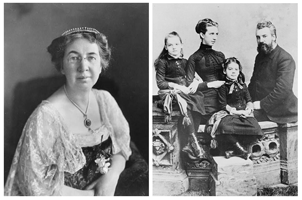 Mabel Gardiner Hubbard was born in Cambridge, Massachussets to a prominent lawyer Gardiner Greene Hubbard and his wife Gertrude Mercer McCurdy.
Mabel Gardiner Hubbard was born in Cambridge, Massachussets to a prominent lawyer Gardiner Greene Hubbard and his wife Gertrude Mercer McCurdy.
As a young child of age five she became ill with scarlet fever and lost her hearing. As a deaf child who previously had developed speech based on her hearing capabilities prior to her illness, her parents wanted to be able to maximize her ability. They sought out the best teachers available in the Boston area. The approach to teaching Mabel incorporated both sign language and lip reading. Efforts to maintain her ability to use her vocal chords and the speech sounds that she had developed in the first years of her life led the Hubbards to seek out the assistance of the best vocal coach in Boston, Alexander Graham Bell.
Although Mabel was not overly impressed with Bell at first, she began to take interest in him as a teacher and then became attached to him as a person. Although ten years her senior, Bell developed a deep personal interest in and affection for his student. Seeking her parents’ permission, and waiting a suitable amount of time as prescribed by Mabel's parents, Bell proposed to Mabel in 1875. Following a year and a half engagement they were married on July 11, 1877.
Bell was always busy with his business and scientific enterprises. He had complete confidence in Mabel and she managed the family finances and all of the operation of their two homes in Washington and Baddeck, Nova Scotia.
Always an avid supporter of Alexander’s work in a variety of fields, Mabel made efforts to encourage him and keep him focused when he worked on too many project areas at one time. Sensing his deep interest in flight, she urged him to take on some associates to help him to solve the mysteries of the principles of flight. Bell countered that when it was time, when he was confident enough in what he was learning from kites, he would seek some helpful colleagues.
During 1907 a group of young men began to gather around the Bells at Beinn Bhreagh, their summer estate in Baddeck. Casey Baldwin and Douglas McCurdy were joined by Glenn Curtiss and Lt. Thomas Selfridge in the late summer of 1907. Sensing the synergy of this group of dynamic and skilled young engineers, Mabel proposed a formal association of the younger men with Dr. Bell.
Putting up $20,000 of her own personal funds (equivalent $2,410,653.99 in 2009 dollars)4, Mabel underwrote the work of the group that took the name "Aerial Experiment Association". She wrote of her excitement at helping to start this venture in letters to her mother.
Later she would travel to Hammonsdsport NY to stay at the home of Glenn and Lena Curtiss while some of the work of the Association unfolded close to the facilities of the Curtiss Motorcycle Company factory.
However, it was not until the Silver Dart arrived in Baddeck on Dec. 15, 1908 that she actually saw one of the Association's airplanes. She was on the ice on Baddeck Bay on February 23, 1909 to witness the flight of the Silver Dart with Douglas McCurdy as pilot. She told her beloved Alec that the sight of the Silver Dart in the air made her fully understand what had driven the five members of the Association to work so hard on solving the problems required to build a successful flying machine.
Over all the years that Alexander worked on his many fields of experimentation, Mabel devoted her attention to her family and the management of their two homes in Washington and Baddeck. Two sons, Edward and Robert, died shortly after birth causing heartache for the Bell family. Two daughters were raised with much joy. Although Alexander was a loving father and devoted to the welfare of his two girls, Mabel was the one who concerned herself with the education and socialization into society of Elsie May Bell and Marian Hubbard Bell (Daisy).
Always interested in world affairs and fiercely independent, Mabel became an advocate for women’s rights. She supported the women’s suffrage movement and took part in a parade down Pennsylvania Avenue in support of the cause. Her interest in education led her to found the first Montessori school in Canada in 1912 and to open a school using the principles of Maria Montessori in Washington DC. She began a discussion group for the women of Baddeck which focused on news stories and issues of the day. That group continues to meet to this day in the town that the Bell's made their summer home.
Mabel only outlived her beloved Alec by five months. During some of that time she organized Dr. Bell's papers so that his record would live on for future generations. She became ill in the third month after Alec's passing and is buried beside him on the estate at Beinn Bhreagh, overlooking Bras d'or Lake and Baddeck.
_______________
Footnotes:
- Toward, Lilias M. Mabel Bell - Alexander's Silent Partner. Sydney, NS. Breton Books, 1996. p 175.
- Craggs, Samantha. Niagara Falls Review: "Former Ridley student helped Bell with inventions". 10-03-2008. pA6
- Selfridge, Thomas E. A Brief Sketch of the Progress of the Art of Aviation. Aerial Experiment Association, Baddeck NS, May 17, 1908. (Contained in the Bulletin of the Aerial Experiment Association. Bulletin No. II, Monday, July 20, 1908).
- Using the "Measuring Worth of Old Money Calculator" the $20,000 dollars invested by Mabel Bell in the Aerial Experiment Association is calculated to be well over $2,400,000.00 U.S. dollars in 2009.
Additional Reading:
- The Intrepid Mr. Curtiss. Stephen W. Sears in American Heritage Magazine, April 1975, Volume 26, Issue 3.
- Man in Motion. Carrie Brown in Invention and Technology Magazine, Spring-Summer, 1991, Volume 7, Issue No. 1.




